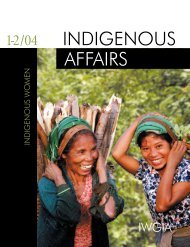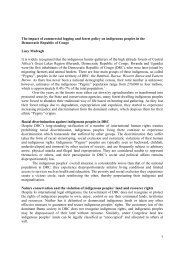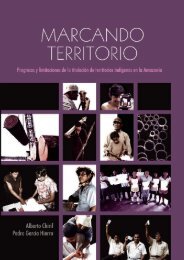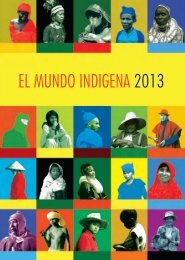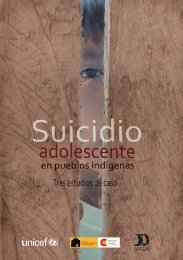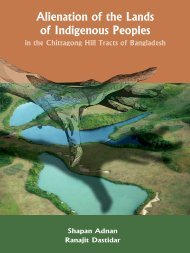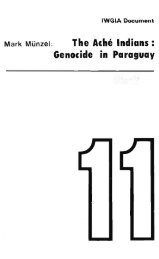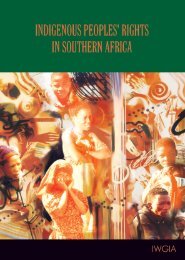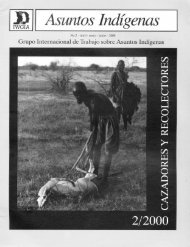Download (pdf) - iwgia
Download (pdf) - iwgia
Download (pdf) - iwgia
Create successful ePaper yourself
Turn your PDF publications into a flip-book with our unique Google optimized e-Paper software.
EDITORIAL<br />
EDITORIAL<br />
Jens Dahl & Geneviève Rose<br />
In many parts of the world, indigenous peoples<br />
suffer from a history of discrimination and exclusion<br />
that has left them on the margins of the<br />
wider societies in which they exist. For this reason,<br />
they face great difficulties in maintaining and<br />
developing their own models of development and<br />
are disproportionately affected by poverty and exclusion.<br />
Under the basic principles of universality,<br />
equality and non-discrimination, indigenous peoples<br />
are entitled to the full range of individual human<br />
rights established in international law. However,<br />
in order to be able to enjoy equal rights as<br />
compared with other collectivities, and in order to<br />
be able to assert their self-determined development,<br />
special measures are required.<br />
This issue of Indigenous Affairs is a combined issue<br />
that brings together a mixture of different articles<br />
and perspectives on development, self-determination<br />
and the role of customary law. The articles touch upon<br />
indigenous peoples’ economic, legal, social and political<br />
development.<br />
Self-Determination and Development<br />
4<br />
Indigenous Affairs 1-2/10<br />
Indigenous peoples, as collectivities, have distinct<br />
and unique cultures, systems and world views, and<br />
their current needs and aspirations for the future may<br />
differ from those of the mainstream population. Indigenous<br />
peoples’ lives and futures can only be assured<br />
through the recognition and protection of not<br />
only their individual rights but also their collective<br />
rights as distinct peoples. It is thus when their right to<br />
self-determination, as enshrined in the UN Declaration<br />
on the Rights of Indigenous Peoples, is asserted<br />
that indigenous peoples’ collective rights can be realized<br />
in a meaningful way.<br />
During the whole negotiation process for the drafting<br />
of the UN Declaration on the Rights of Indigenous<br />
Peoples, indigenous peoples consistently defended<br />
recognition of their right to self-determination as a prerequisite<br />
to the protection and promotion, as well as<br />
exercise and enjoyment, of all their rights. Indigenous<br />
peoples insisted that, besides individual human rights,<br />
collective rights are a cornerstone of indigenous communities<br />
and cultures. Communality and collectivity<br />
permeate their spirituality, relationship with the land,<br />
ways of resolving conflict, their view on the environment<br />
and their development aspirations. Indigenous<br />
peoples’ views on the future and desires for increased<br />
well-being are, first and foremost, of a communal orientation<br />
and linked to the collectivity more than to the<br />
individual human being. Increased well-being and<br />
control of one’s future is the epitome of indigenous<br />
peoples’ development, whether the emphasis is on<br />
economic prosperity, customary laws, conflict resolution<br />
or spiritual relations. In this volume, Dalee Sambo<br />
illustrates how development is an inalienable right and<br />
an integral part of indigenous peoples’ self-determination,<br />
as stipulated in the Declaration, by using the example<br />
of the Alaska Native Claims Settlement Act.<br />
As Victoria Tauli Corpuz 1 has stated on several occasions,<br />
there is a need for a human development model<br />
that provides indigenous peoples with the possibility of<br />
continuing to live on their lands and decide how their<br />
natural resources are going to be used, and this means<br />
that it has to be indigenous peoples themselves who<br />
should decide what kind of cultural, economic, legal<br />
and spiritual development they want. Such self-determined<br />
development would respect indigenous peoples’<br />
culture and identity and would reflect indigenous peoples’<br />
own visions, perspectives and strategies.<br />
Most recently, the communality or collectivity of indigenous<br />
peoples has been revived within the celebration<br />
and respect of “Mother Earth”. The concept of<br />
Mother Earth as used by indigenous peoples in the<br />
Americas contains religious elements but, first and<br />
foremost, it represents cultural values and a desire to<br />
take care of future generations. Linked to the concept<br />
of Mother Earth is the notion of Living Well. Living<br />
Well expresses the close relationship between living<br />
beings and nature and it links to the historic past of<br />
indigenous self-determination before invasion and<br />
conquest. It is the opposite of resource exploitation,<br />
commercialization and oppression and gives priority<br />
to subsistence, and the renewable and sustainable use<br />
of nature. In this way, it represents an indigenous form<br />
of development as an alternative to Western dominated<br />
capitalist development. There are reasons to be cautious,<br />
however, with regard to the increasing use of<br />
references to the rights of Mother Earth within or interrelated<br />
to the international human rights framework.<br />
1 Member of the United Nations Permanent Forum on Indigenous<br />
Issues (UNFPII) and Executive Director of the Tebtebba<br />
Foundation, an indigenous peoples’ policy research center<br />
based in the Philippines.



